Inhibitor of Apoptosis Protein-Like Protein-2 as a Novel Serological Biomarker for Breast Cancer
Abstract
:1. Introduction
2. Results and Discussion
2.1. Comparison of Serum Proteins with 2DE
2.2. Peptide Mass Fingerprinting Analysis
2.3. Western Blot Analysis of the ILP-2 Levels in the Breast Cancer and Non-Cancer Serum Samples
2.4. Comparison of 2DE with Five Types of Serum Samples
2.5. ELISA Analysis of ILP-2 Levels in Five Types of Serum Samples
3. Materials and Methods
3.1. Ethical Statement
3.2. Patients
3.3. Serum Sample Preparation for Two-Dimensional Gel Electrophoresis (2DE)
3.4. Protein Quantification
3.5. 2DE
3.6. Protein Spot Change Analysis and Peptide Mass Analysis
3.7. Western Blot Analysis
3.8. Enzyme-Linked Immunosorbent Assay (ELISA) Analysis
3.9. Statistics Analysis
4. Conclusions
Acknowledgments
References
- Jemal, A.; Siegel, R.; Ward, E.; Murray, T.; Xu, J.; Smigal, C.; Thun, M.J. Cancer statistics, 2006. CA Cancer J. Clin 2006, 56, 106–130. [Google Scholar]
- Parkin, D.M.; Bray, F.; Ferlay, J.; Pisani, P. Global cancer statistics, 2002. CA Cancer J. Clin 2005, 55, 74–108. [Google Scholar]
- Fu, X.L. Common Malignant Tumors in Breast Cancer Diagnosis and Treatment Volumes; Beijing Medical University and Peking Union Medical College in China Joint Press: Beijing, China, 1999. [Google Scholar]
- Shin, H.; Renatus, M.; Eckelman, B.P.; Nunes, V.A.; Sampaio, C.A.M.; Salvesen, G.S. The BIR domain of IAP-like protein 2 is conformationally unstable: Implications for caspase inhibition. Biochem. J 2005, 385, 1–10. [Google Scholar]
- Salvesen, G.S.; Duckett, C.S. IAP proteins: Blocking the road to death’s door. Nat. Rev. Mol. Cell Biol 2002, 3, 401–410. [Google Scholar]
- Deveraux, Q.L.; Takahashi, R.; Salvesen, G.S.; Reed, J.C. X-linked IAP is a direct inhibitor of cell death proteases. Nature 1997, 388, 300–304. [Google Scholar]
- Roy, N.; Deveraux, Q.L.; Takahashi, R.; Salvesen, G.S.; Reed, J.C. The c-IAP-1 and c-IAP-2 proteins are direct inhibitors of specific caspases. EMBO J 1997, 16, 6914–6925. [Google Scholar]
- Maier, J.K.X.; Lahoua, Z.; Gendron, N.H.; Fetni, R.; Johnston, A.; Davoodi, J.; Rasper, D.; Roy, S.; Slack, R.S.; Nicholson, D.W.; et al. The neuronal apoptosis inhibitory protein is a direct inhibitor of caspases 3 and 7. J. Neurosci 2002, 22, 2035–2043. [Google Scholar]
- Vucic, D.; Stennicke, H.R.; Pisabarro, M.T.; Salvesen, G.S.; Dixit, V.M. ML-IAP, a novel inhibitor of apoptosis that is preferentially expressed in human melanomas. Curr. Biol 2000, 10, 1359–1366. [Google Scholar]
- Kasof, G.M.; Gomes, B.C. Livin, a novel inhibitor of apoptosis protein family member. J. Biol. Chem 2001, 276, 3238–3246. [Google Scholar]
- Conway, E.M.; Pollefeyt, S.; Cornelissen, J.; DeBaere, I.; Steiner-Mosonyi, M.; Ong, K.; Baens, M.; Collen, D.; Schuh, A.C. Three differentially expressed survivin cDNA variants encode proteins with distinct antiapoptotic functions. Blood 2000, 95, 1435–1442. [Google Scholar]
- Shin, S.; Sung, B.J.; Cho, Y.S.; Kim, H.J.; Ha, N.C.; Hwang, J.I.; Chung, C.W.; Jung, Y.K.; Oh, B.H. An anti-apoptotic protein human survivin is a direct inhibitor of caspase-3 and -7. Biochemistry 2001, 40, 1117–1123. [Google Scholar]
- Bartke, T.; Pohl, C.; Pyrowolakis, G.; Jentsch, S. Dual role of BRUCE as an antiapoptotic IAP and a chimeric E2/E3 ubiquitin ligase. Mol. Cell 2004, 14, 801–811. [Google Scholar]
- Richter, B.W.M.; Mir, S.S.; Eiben, L.J.; Lewis, J.; Reffey, S.B.; Frattini, A.; Tian, L.; Frank, S.; Youle, R.J.; Nelson, D.L.; et al. Molecular cloning of ILP-2, a novel member of the inhibitor of apoptosis protein family. Mol. Cell Biol 2001, 21, 4292–4301. [Google Scholar]
- Lagacé, M.; Xuan, J.Y.; Young, S.S.; McRoberts, C.; Maier, J.; Rajcan-Separovic, E.; Korneluk, R.G. Genomic organization of the X-linked inhibitor of apoptosis and identification of a novel testis-specific transcript. Genomics 2001, 77, 181–188. [Google Scholar]
- Swatton, J.E.; Prabakaran, S.; Karp, N.A.; Lilley, K.S.; Bahn, S. Protein profiling of human postmortem brain using 2-dimensional fluorescence difference gel electrophoresis (2-D DIGE). Mol. Psychiatry 2004, 9, 128–143. [Google Scholar]
- Chang, J.W.; Kang, U.B.; Kim, D.H.; Yi, J.K.; Lee, J.W.; Noh, D.Y.; Lee, C.; Yu, M.H. Identification of circulating endorepellin LG3 fragment: Potential use as a serological biomarker for breast cancer. Proteomics Clin. Appl 2008, 2, 23–32. [Google Scholar]
- Hu, S.; Loo, J.A.; Wong, D.T. Human body fluid proteome analysis. Proteomics 2006, 6, 6326–6353. [Google Scholar]
- Karsan, A.; Eigl, B.J.; Flibotte, S.; Gelmon, K.; Switzer, P.; Hassell, P.; Harrison, D.; Law, J.; Hayes, M.; Stillwell, M.; et al. Analytical and preanalytical biases in serum proteomic pattern analysis for breast cancer diagnosis. Clin. Chem 2005, 51, 1525–1528. [Google Scholar]
- Görg, A.; Postel, W.; Günther, S. Two-dimensional electrophoresis, the current state of two-dimensional electrophoresis with immobilized pH gradients. Electrophoresis 1988, 9, 531–546. [Google Scholar]
- Smithies, O.; Poulik, M.D. Two-dimensional electrophoresis of serum proteins. Nature 1956, 177, 1033. [Google Scholar]
- Ramagli, L.S. Quantifying protein in 2-D PAGE solubilization buffers. Methods Mol. Biol 1999, 112, 99–103. [Google Scholar]
- Herbert, B.; Calvani, M.; Hamdan, M.; Olivieri, E.; MacCarthy, J.; Pedersen, S.; Righetti, P.G. Reduction and alkvlalion of proteins in preparation of two-dimensional map analysis: Why, when, and how? Electrophoresis 2001, 22, 2046–2057. [Google Scholar]
- Alban, A.; David, S.O.; Bjorkesten, L.; Andersson, C.; Sloge, E.; Lewis, S.; Currie, I. A novel experimental design for comparative two-dimensional gel analysis: Two-dimensional difference gel electrophoresis incorporating a pooled internal standard. Proteomics 2003, 3, 36–44. [Google Scholar]
- Hu, Y.; Malone, J.P.; Fagan, A.M.; Townsend, R.R.; Holtzman, D.M. Comparative proteomic analysis of intra- and interindividual variation in human cerebrospinal fluid. Mol. Cell Proteomics 2005, 4, 2000–2009. [Google Scholar]
- Mortz, E.; Krogh, T.N.; Vorum, H.; Görg, A. Improved silver staining protocols for high sensitivity protein identification using matrix-assisted laser desorption/ionization-time of flight analysis. Proteomics 2001, 1, 1359–1363. [Google Scholar]
- Knowles, M.R.; Cervino, S.; Skynner, H.A.; Hunt, S.P.; de Felipe, C.; Salim, K.; Meneses-Lorente, G.; McAllister, G.; Guest, P.C. Multiplex proteomic analysis by two-dimensional differential in-gel electrophoresis. Proteomics 2003, 3, 1162–1171. [Google Scholar]
- Karp, N.A.; Griffin, J.L.; Lilley, K.S. Application of partial least squares discriminant analysis to two-dimensional difference gel studies in expression proteomics. Proteomics 2005, 5, 81–90. [Google Scholar]
- Lee, I.N.; Chen, C.H.; Sheu, J.C.; Lee, H.S.; Huang, G.T.; Yu, C.Y.; Lu, F.J.; Chow, L.P. Identification of human hepatocellular carcinoma-related biomarkers by two-dimensional difference gel electrophoresis and mass spectrometry. J. Proteome Res 2005, 4, 2062–2069. [Google Scholar]
- Zhou, G.; Li, H.; DeCamp, D.; Chen, S.; Shu, H.; Gong, Y.; Flaig, M.; Gillespie, J.W.; Hu, N.; Taylor, P.R.; et al. 2D differential in-gel electrophoresis for the identification of esophageal scans cell cancer-specific protein markers. Mol. Cell Proteomics 2002, 1, 117–123. [Google Scholar]
- Shevchenko, A.; Wilm, M.; Vorm, O.; Mann, M. Mass spectrometric sequencing of proteins from silver-stained polyacrylamide gels. Anal. Chem 1996, 68, 850–858. [Google Scholar]
- Lee, K.; Bae, D.; Lim, D. Evaluation of parameters in peptide mass fingerprinting for protein identification by MALDI-TOF mass spectrometry. Mol. Cells 2002, 13, 175–184. [Google Scholar]
- Karas, M.; Hillenkamp, F. Laser desorption ionization of proteins with molecular masses exceeding 10,000 daltons. Anal. Chem 1988, 60, 2299–2301. [Google Scholar]
- Mann, M.; Hendrickson, R.C.; Pandey, A. Analysis of proteins and proteomes by mass spectrometry. Annu. Rev. Biochem 2001, 70, 437–473. [Google Scholar]
- Ficarro, S.B.; McCleland, M.L.; Stukenberg, P.T.; Burke, D.J.; Ross, M.M.; Shabanowitz, J.; Hunt, D.F.; White, F.M. Phosphoproteome analysis by mass spectrometry and its application to Saccharomyces cerevisiae. Nat. Biotechnol 2002, 20, 301–305. [Google Scholar]
- Galvani, M.; Hamdan, M.; Herbert, B.; Righetti, P.G. Alkylation kinetics of proteins in preparation for two-dimensional maps: A matrix assisted laser desorption/ionization-mass spectrometry investigation. Electrophoresis 2001, 22, 2058–2065. [Google Scholar]
- Seo, H.S.; Choi, H.S.; Choi, H.S.; Choi, Y.K.; Um, J.Y.; Choi, I.; Shin, Y.C.; Ko, S.G. Phytoestrogens induce apoptosis via extrinsic pathway, inhibiting nuclear factor-κB signaling in HER2-overexpressing breast cancer cells. Anticancer Res 2011, 31, 3301–3313. [Google Scholar]
- Thrum, S.; Lorenz, J.; Mössner, J.; Wiedmann, M. Polo-like kinase 1 inhibition as a new therapeutic modality in therapy of cholangiocarcinoma. Anticancer Res 2011, 31, 3289–3299. [Google Scholar]
- Zee, B.M.; Young, N.L.; Garcia, B.A. Quantitative proteomic approaches to studying histone modifications. Curr. Chem. Genomic 2011, 5, S106–S114. [Google Scholar]
- Brown, M.D.; Feairheller, D.L.; Thakkar, S.; Veerabhadrappa, P.; Park, J.Y. Racial differences in tumor necrosis factor-α-induced endothelial microparticles and interleukin-6 production. Vasc. Health Risk Mana 2011, 7, 541–550. [Google Scholar]
- Karliner, J.S.; Gander, M.P.; Sobel, B.E. Elevated serum glyceraldehydes phosphate dehydrogenase activity following acute myocardial infarction. CHEST 1971, 60, 318–323. [Google Scholar]
- Shibuya, A.; Ikewaki, N. High serum glyceraldehyde-3-phosphate dehydrogenase levels in patients with liver cirrhosis. Hepatol. Res 2002, 22, 174–179. [Google Scholar]
- Kirkham, P.A.; Caramori, G.; Casolari, P.; Papi, A.A.; Edwards, M.; Shamji, B.; Triantaphyllopoulos, K.; Hussain, F.; Pinart, M.; Khan, Y.; et al. Oxidative stress-induced antibodies to carbonyl-modified protein correlate with severity of chronic obstructive pulmonary disease. Am. J. Respir. Crit. Care Med 2011, 184, 796–802. [Google Scholar]
- Kashyap, B.; Sinha, S.; Das, S.; Rustagi, N.; Jhamb, R. Efficiency of diagnostic methods for correlation between prevalence of enteric protozoan parasites and HIV/AIDS status—An experience of a tertiary care hospital in East Delhi. J. Parasit. Dis 2010, 34, 63–67. [Google Scholar]
- Tutino, V.; Notarnicola, M.; Guerra, V.; Lorusso, D.; Caruso, M.G. Increased soluble leptin receptor levels are associated with advanced tumor stage in colorectal cancer patients. Anticancer Res 2011, 31, 3381–3383. [Google Scholar]
- Bagai, U.; Pawar, A.; Kumar, V. Antibody responses to 43 and 48 kDa antigens of blood-stage Plasmodium berghei in Balb/c mice. J. Parasit. Dis 2010, 34, 68–74. [Google Scholar]
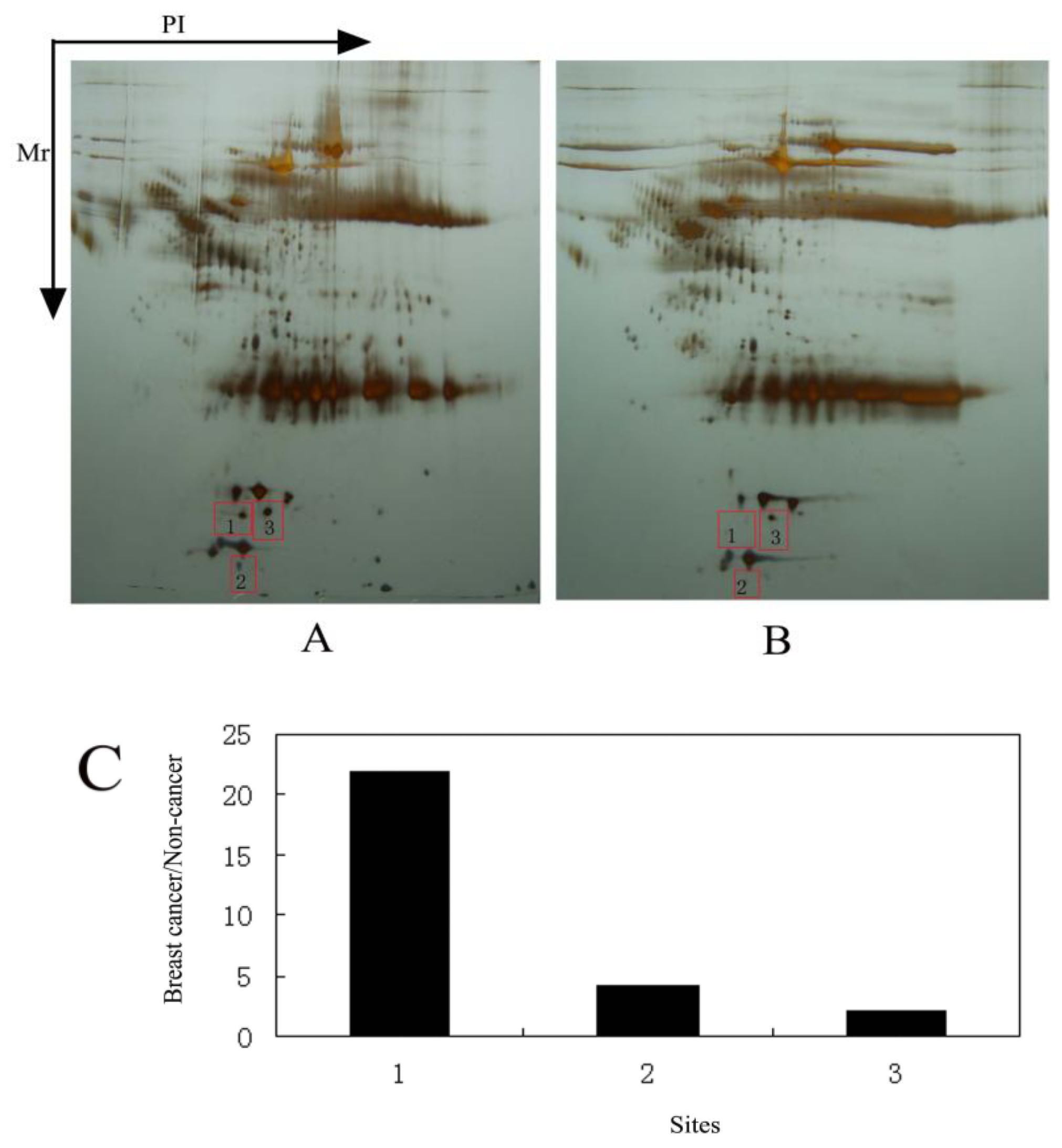
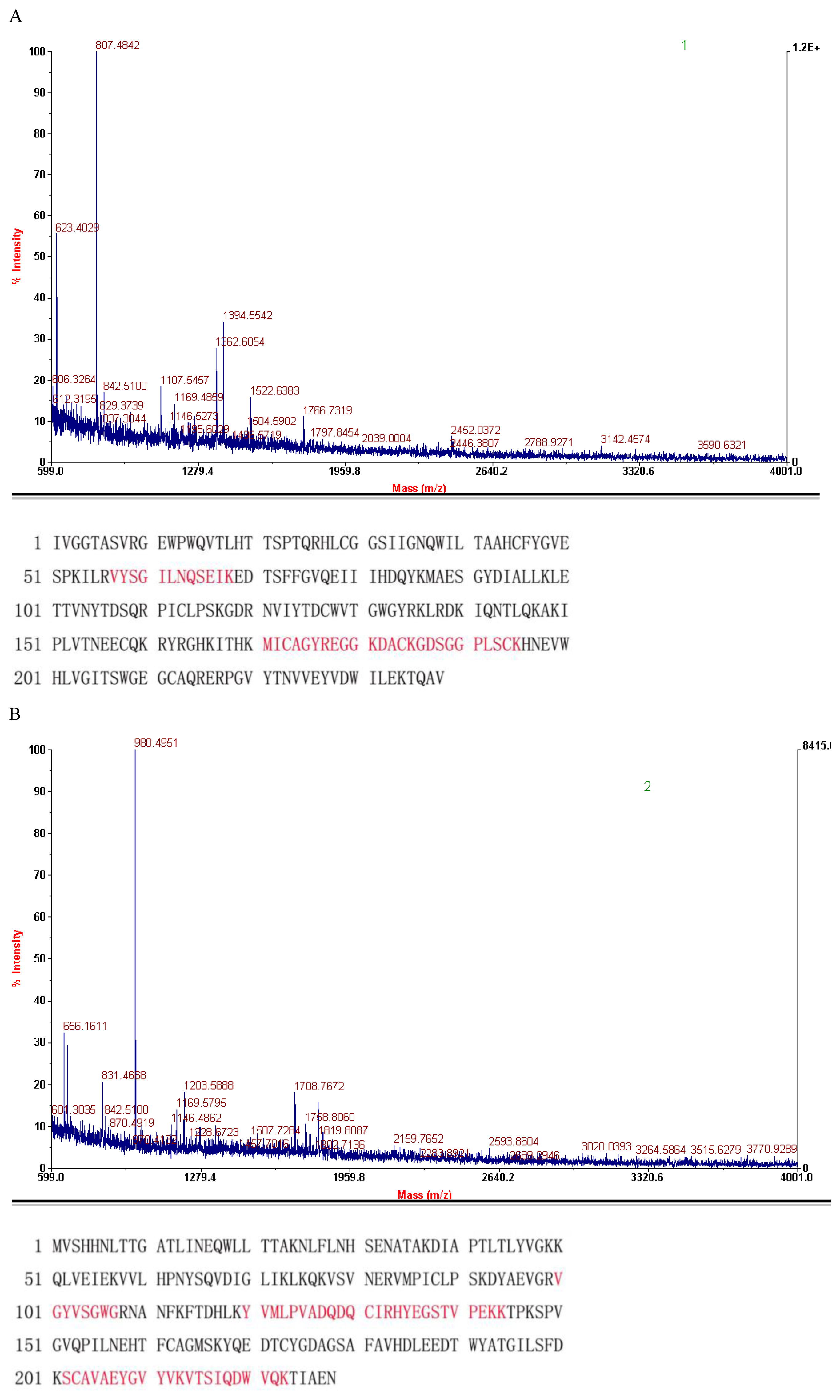
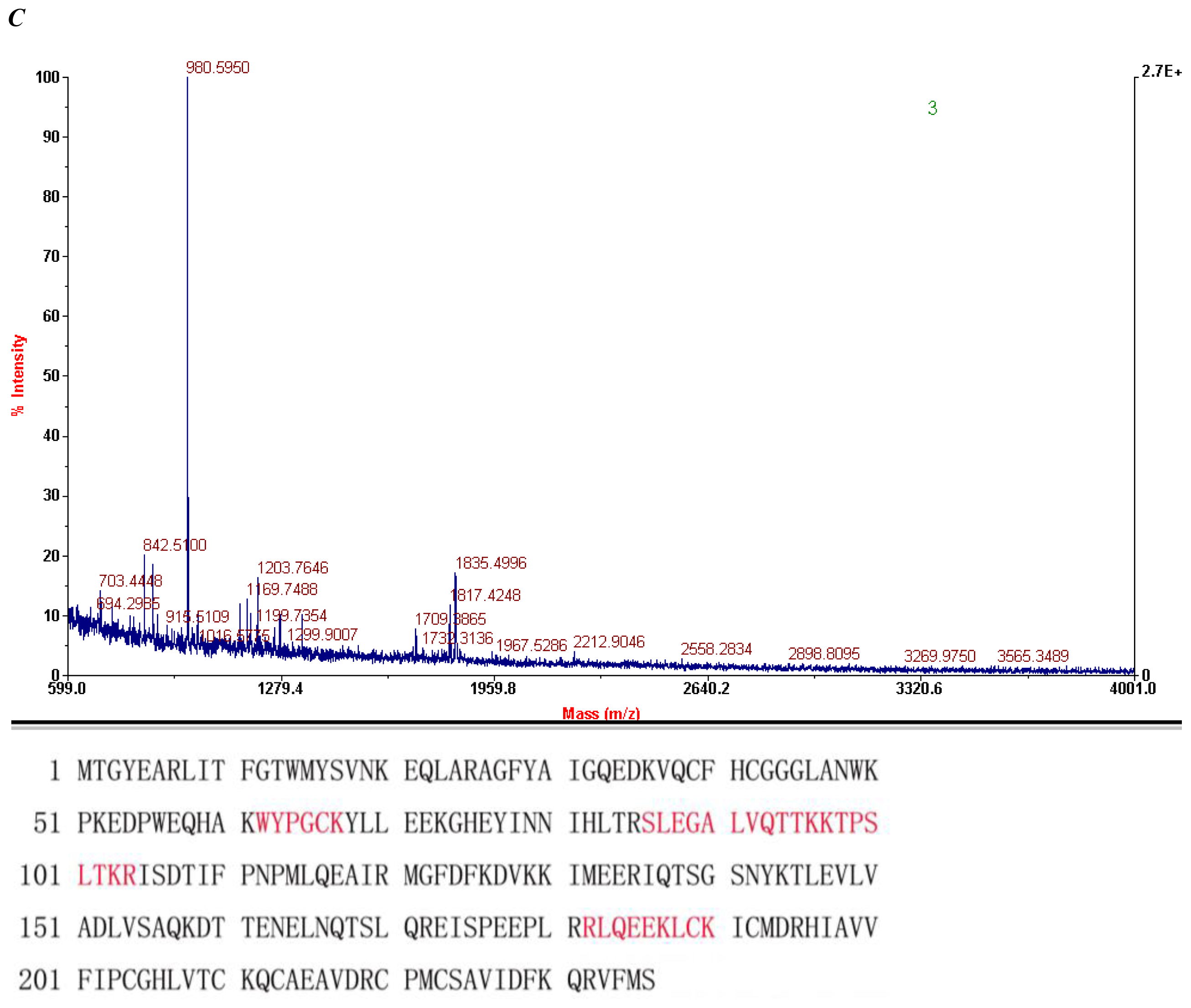

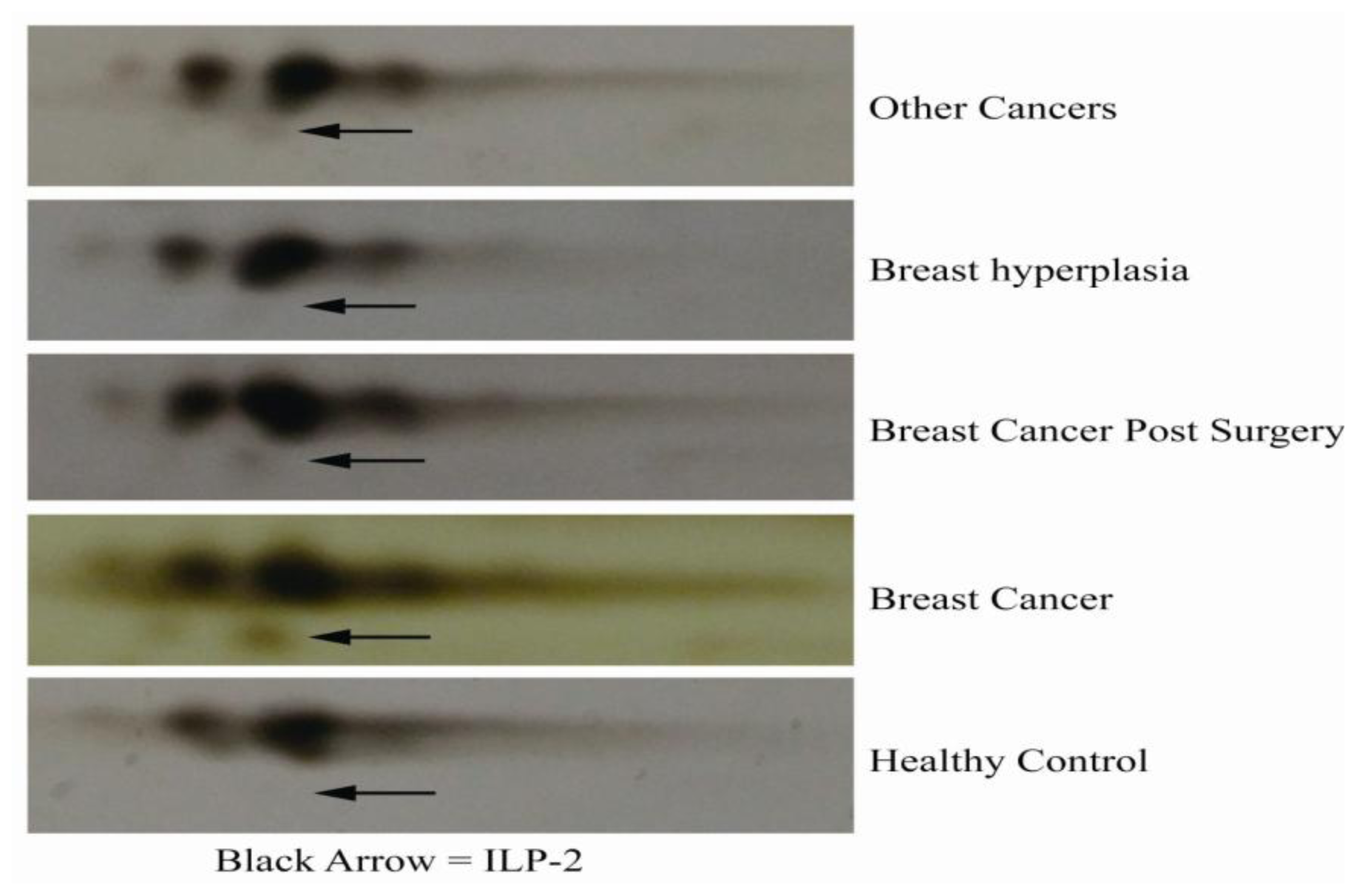
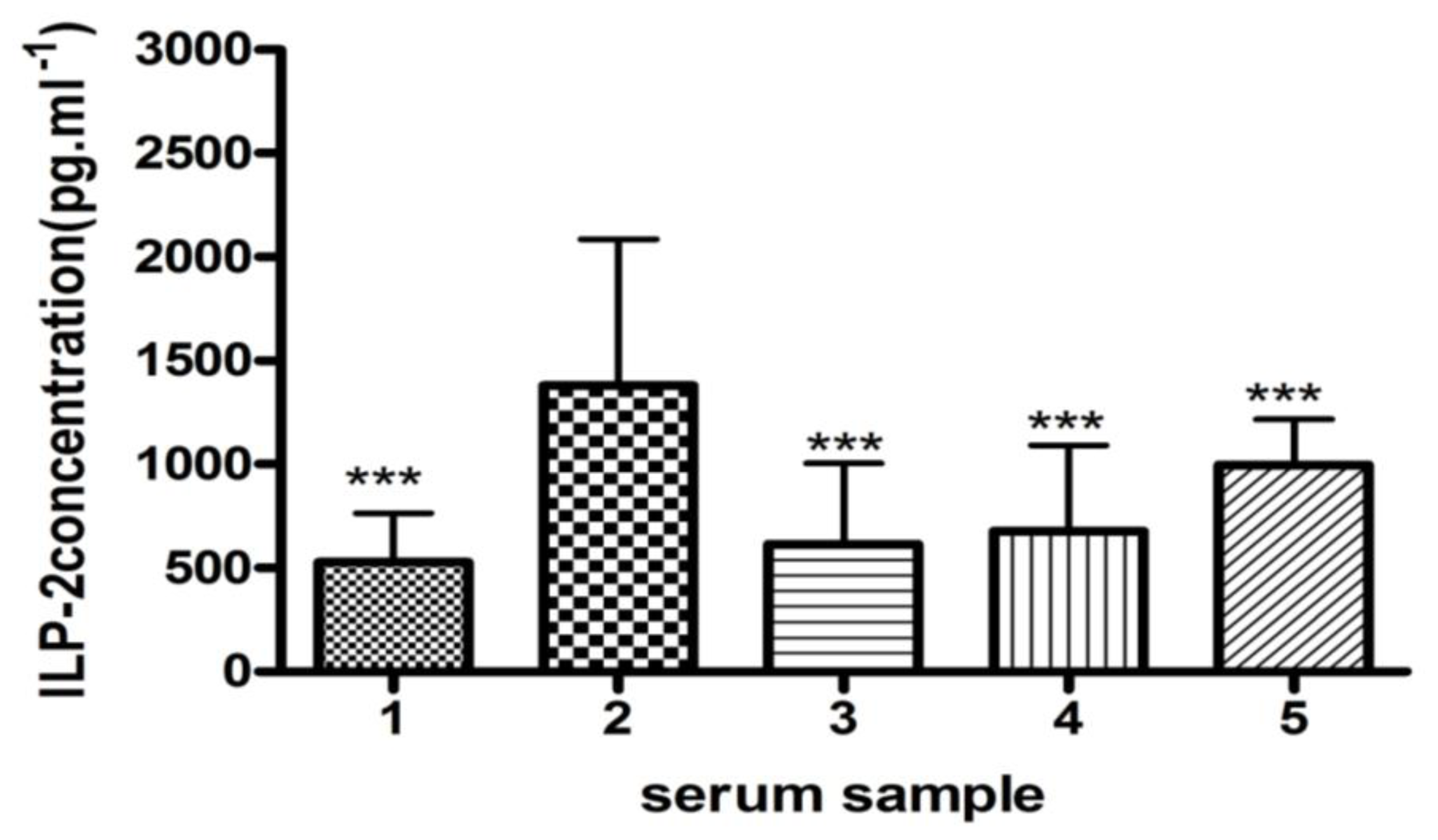
| No. | Protein | Matched peptides | GenBank accession no. | Top score | Significance | Function |
|---|---|---|---|---|---|---|
| 1 | Fxia Catalytic Domain | 5 | gi|56967288 | 64 | p < 0.05 | The Fxia catalytic domain in complex with ecotinm84r |
| 2 | HP protein | 5 | gi|34785974 | 74 | p < 0.05 | Haptoglobin alpha (2FS)-beta precursor |
| 3 | ILP-2 | 9 | gi|15042064 | 54 | p < 0.05 | Testis-specific inhibitor of apoptosis |
| Sample source | Type of sample | Number of samples | Type of analysis |
|---|---|---|---|
| The Third Hospital of Kunming Medical College, Kunming, China | Breast cancer | 400 | 2DE, MALDI TOF MS |
| Non-cancer | 40 | 2DE, MALDI TOF MS | |
| The First Hospital of Gannan Medical College, Ganzhou, China | Breast cancer | 10 | WB |
| 35 | 2DE, ELISA | ||
| Non-cancer | 10 | WB | |
| 35 | 2DE, ELISA | ||
| Galactophore hyperplasia | 35 | 2DE, ELISA | |
| Breast cancer post-surgery | 35 | 2DE, ELISA | |
| Other cancer types | 35 | 2DE, ELISA | |
| Parameter types | Search parameters |
|---|---|
| Type of search | Peptide Mass Fingerprint |
| Enzyme | Trypsin |
| Variable modifications | Carbamidomethyl (C) |
| Mass values | Monoisotopic |
| Protein Mass | Unrestricted |
| Peptide Mass Tolerance | ±0.15 Da |
| Peptide Charge State | 1+ |
| Max Missed Cleavages | 2 |
| Number of queries | 13 |
© 2012 by the authors; licensee Molecular Diversity Preservation International, Basel, Switzerland. This article is an open-access article distributed under the terms and conditions of the Creative Commons Attribution license (http://creativecommons.org/licenses/by/3.0/).
Share and Cite
Xiang, M.; Zhou, W.; Gao, D.; Fang, X.; Liu, Q. Inhibitor of Apoptosis Protein-Like Protein-2 as a Novel Serological Biomarker for Breast Cancer. Int. J. Mol. Sci. 2012, 13, 16737-16750. https://doi.org/10.3390/ijms131216737
Xiang M, Zhou W, Gao D, Fang X, Liu Q. Inhibitor of Apoptosis Protein-Like Protein-2 as a Novel Serological Biomarker for Breast Cancer. International Journal of Molecular Sciences. 2012; 13(12):16737-16750. https://doi.org/10.3390/ijms131216737
Chicago/Turabian StyleXiang, Mingjun, Wei Zhou, Dandan Gao, Xiansong Fang, and Qian Liu. 2012. "Inhibitor of Apoptosis Protein-Like Protein-2 as a Novel Serological Biomarker for Breast Cancer" International Journal of Molecular Sciences 13, no. 12: 16737-16750. https://doi.org/10.3390/ijms131216737




